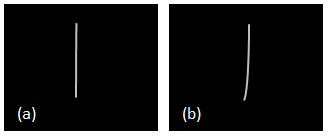Fundamentals of Fluid Flow in Porous Media
Chapter 3
Diffusion Coefficient: Measurement Techniques
Refractive Index Method
Refractive index is the ratio of the velocity of wave propagation in a reference phase to that in the phase of interest. Normally, the refractive index used in diffusion measurement is taken as the ratio of the velocity of light in vacuum to the velocity of light in the relevant phase:

Where,
c = velocity of light in vacuum,
n = velocity of light in the relevant phase, and
n = refractive index.
With the velocity of light in vacuum chosen as the reference, the refractive index is always greater than 1. For example, the refractive index of water is 1.33, meaning that light travels 1.33 times as fast in vacuum as it does in water. As light moves from a medium, such as air, water, or glass, into another it may change its propagation direction in proportion to the change in refractive index.

Figure 3-7: Refraction of Light at the Interface between Two Media
Eq. (3‑29), Snell’s law (also known as the Snell–Descartes law, and the law of refraction), is a formula used to describe the relationship between the angles of refraction and refraction index, when referring to light or other waves passing through a boundary between two different isotropic media, such as two fluid with different concentration of a solvent.

Where, θ is the angle of refraction.
It is noted that, for a solution, different concentrations of a sample substance will lead to different refractive indices. As a result, from the angle of refraction, the concentration of a solution phase can be determined. Normally, in experimental measurements of refractive indices, a laser light is emitted through the diffusion cell and, according to the concentration of the solution at each elevation, the corresponding refractive angle of the laser beam is determined. As a result, the point at which the laser beam is captured by a CCD camera will represent the concentration inside the diffusion cell at that specific elevation. Figure 3‑8 shows a sample picture of CCD during the diffusion process.

Figure 3-8: Sample of Light Refraction Results a) Initial Time, b) After Diffusion Occurred
It is noted that the above method is suitable only for transparent fluids. As heavy oil, even when diluted, is opaque, such a method cannot be employed.
NMR METHOD >>
Questions?
If you have any questions at all, please feel free to ask PERM! We are here to help the community.
